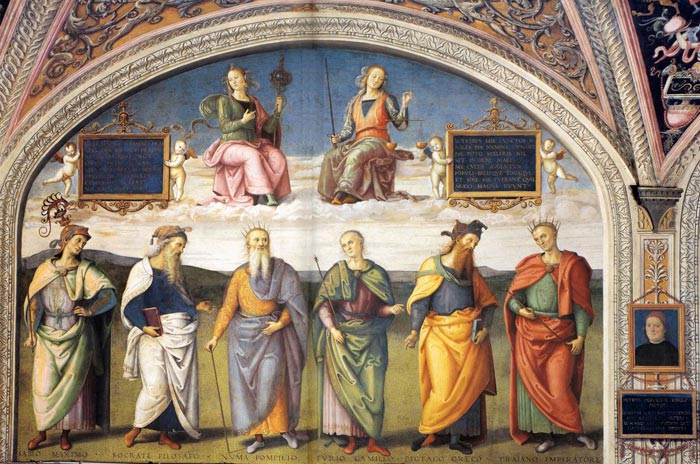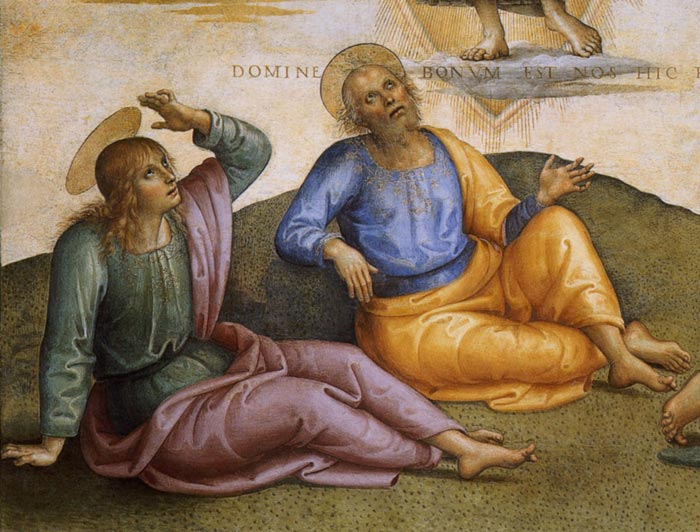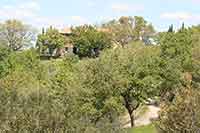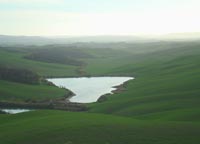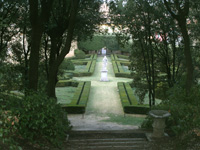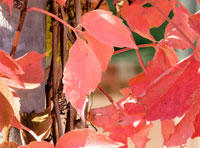| |
|
| The Collegio del Cambio in Perugia is an extremely well preserved representation of a Renaissance building and houses a magnificent Pietro Perugino fresco. The Arte del Cambio (the moneychangers' guild) was one of the most influential of the many guilds in Perugia. In the fifteenth century it was a crucial institution in the city's power structure. Its chief responsibility was to guarantee the value of the coinage in circulation. The guild's "bottega" was something like a bank counter, where coins were appraised and their authenticity and exchange value confirmed.
The guild's headquarters are on the Corso Vannucci, right next to the Palazzo dei Priori. The structure's three ground-floor rooms have been preserved essentially in their original condition. These spaces had previously belonged to a monastery, in 1428, Pope Martin V granted the guild the use of the building. One room, the so-called Sala dei Legisti, originally was a shop, now it serves as the entrance to the Collegio del Cambio. The main room is the Sala di Udienza, while the third room is a chapel consecrated to John the Baptist.
The first room, the Sala dei Legisti (lawyers room), contains inlaid furniture and wood panellings against the walls by Giampietro Zuccari (1615-21). This room leads to the Sala dell’Udienza (council room), which is the finest and best preserved 15th century secular room in Italy.
In the Sala di Udienza the Florentine woodcarver Domenico del Tasso (1440-1508) created the inlaid paneling and the richly carved "tribunal," or judges' bench in 1491-92. Perugino was commissioned for the fresco decoration in 1496, and the entire project was completed in 1500, the date that appears prominently on a painted tablet across from Perugino's self-portrait and signature.
The design of the complex program of the fresco decoration is the work of a highly sophisticated scholar, the humanist Francesco Maturanzio (1443-1518), who had been a teacher of rhetoric and poetry in Ferrara and Vicenza before he returned to his native Perugia in 1497.
Each of the two compartments (lunettes) on the left wall presents a row of six figures standing in front of a low landscape horizon. Above these, personifications of the four cardinal virtues sit enthroned on clouds, two in each lunette. Beside each of the Virtues is an ornamental inscription tablet flanked by putti and containing a Latin distich identifying her and celebrating the exemplars below. Each trio of figures is made up of two Romans and one Greek; their names appear on the ground beneath their feet. The narrower lunettes on the back wall present two Christian themes, the Transfiguration of Christ and the Nativity. The front half of the right wall is taken up by the carved tribunal. In the lunette to the left of it are groupings of six prophets and six sibyls, each provided with a fragmentary prophecy on an inscription ribbon. God the Father appears above, holding the orb of the world. His mandorla is framed by heads of seraphim and flanked by adoring angels. The ceiling, which consists of two adjoining cross-ribbed vaults, presents the seven planetary gods on triumphal cars in round medallions, the wheels of their cars decorated with the twelve signs of the zodiac.[1].
|
|
|
|
| |
|
The Sala di Udienza
|
On the back wall the scenes of the Transfiguration and the Adoration of the Shepherds can be seen, on the right wall the group of Prophets and Sibyls is depicted, and the statue of Justitia is placed between two carved griffins.
Because of its vaulted ceiling decorated with grotesques, the Sala di Udienza (Council Room) seems taller than it actually is. Its decor appears so consistent that one would not suspect that it was actually executed in several stages. The Florentine woodcarver Domenico del Tasso (1440-1508) created the inlaid paneling and the richly carved "tribunal," or judges' bench in 1491-92. The walls were decorated with frescoes by Perugino in 1497-1500.
The iconography on the walls are inspired by the triumph of the Virtues, following the model of Catone l’Uticense: the four Cardinal Virtues - Prudence, Justice, Strength and Temperance - embodied in exemplary figures taken from Greek and Roman history, and the three Theological Virtues - Faith, Hope and Charity - represented by the Transfiguration of Christ, the Nativity and the Prophets and the Sibyls. On the vault the triumph of the Planets is depicted, hinting at fortune. These frescoes are a masterpiece of Italian humanistic painting, surpassed only by the decoration of the Vatican Rooms by Raphael.
Each of the two compartments (lunettes) on the left wall presents a row of six figures standing in front of a low landscape horizon. Above these, personifications of the four cardinal virtues sit enthroned on clouds, two in each lunette. Beside each of the Virtues is an ornamental inscription tablet flanked by putti and containing a Latin distich identifying her and celebrating the exemplars below. Each trio of figures is made up of two Romans and one Greek; their names appear on the ground beneath their feet.
The represented famous men in the first compartment are Fabius Maximus, Socrates, Numa Pompilius, Furius Camillus, Pittacus, and Trajan. Above them the Cardinal Virtues Prudentia and Justitia are depicted. At the right we can see Perugino's self-portrait.
For his arrangement of the heroes in the lunettes, Perugino borrowed from Ghirlandaio's paintings in the Sala dei Gigli in Florence's Palazzo Vecchio. More than likely he knew those works firsthand, for he had himself been commissioned to execute some of the paintings in that room in 1482.
The combination of ancient heroes with personifications of Virtues was prefigured in the cycle of paintings by Taddeo di Bartolo for the antechapel of the Palazzo Pubblico, Siena.
In the compartment of the right wall, on the left the prophets Isaiah, Moses, Daniel, David, Jeremiah, and Solomon are represented. On the right the Eritrean, Persian, Cumaean, Libyan, Tiburtine, and Delphian sibyls are depicted. Each figure is provided with a fragmentary prophecy on an inscription ribbon.
Above, God the Father in a gloriole surrounded by angels can be seen.
|
|
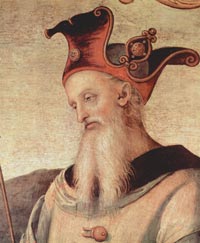 Pericle, dettaglio Pericle, dettaglio
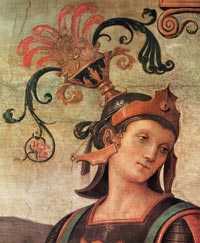 Lucius Sicinius Lucius Sicinius
|
Transfiguration
|
|
Pietro Perugino, The Transfiguration of Christ (detail), fresco, Collegio del Cambio, Perugia
|
On the back wall the scenes of The Transfiguration of Christ and Nativity with the Adoration of the Shepherds are depicted.
HIC EST FILIVS MEVS DILECTVS e DOMINE BONVM EST NOS HIC ESSET.
|
|
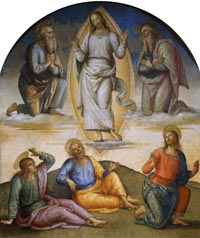
Pietro Perugino, The Transfiguration of Christ
|
Famous Men of Antiquity
|
|
Pietro Perugino, Famous Men of Antiquity, Collegio del Cambio, Perugia
The represented famous men in the second compartment are Lucius Sicinius, Leonidas, Horatius Cocles, Publius Scipio, Pericles, and Quintus Cincinnatus. Above them the Cardinal Virtues Fortitudo and Temperantia are depicted. Perugino's self-portrait is on the left.
|
In February 1499 the first payments were registered to Pietro Perugino and he continued to work there for the entire year, finishing it in 1500, as can be seen by the date written on the central pillar on the right. On the opposite pillar Perugino painted his self-portrait, accompanied by an laudatory inscription: “PETRUS PERUSINUS EGREGIUS / PICTOR / PERDITA SI FUERAT PINGENDI / HIC RETTULIT ARTEM / SI NUSQUAM INVENTA EST / HACTENUS IPSE DEDIT “. The Latin epigram that follows reads: "When the art of colour had been lost, he rediscovered it with patient determination, and when no one was giving it life, he was the first to create art that was beautiful." The verse was doubtless composed by Maturanzio. Its wording and its placement on the pillar between the lunettes presenting ancient paragons of virtue leave no doubt that the painter was proud of his accomplishment. It almost appears as though he wished to be thought of as a Famous Man himself.
Compared to the idealized depictions of classical heroes, Perugino's portrait is quite realistic and modest. His contemporary clothing, the bust format make it clear that he belongs to a different world than the one represented on either side.
Bibliografia
Vittoria Garibaldi, Perugino, in Pittori del Rinascimento, Scala, Firenze 2004
AA.VV., Umbria ("Guida rossa"), Touring Club editore, Milano 1999.

[1] Perugino, byname of Pietro di Cristoforo Vannucci (born c. 1450, Città della Pieve, near Perugia, Romagna [Italy]—died February/March 1523, Fontignano, near Perugia), Italian Renaissance painter of the Umbria school and the teacher of Raphael. His work (e.g., Giving of the Keys to St. Peter, 1481–82, a fresco in the Sistine Chapel in Rome) anticipated High Renaissance ideals in its compositional clarity, sense of spaciousness, and economy of formal elements.
Collegio del Cambio
Corso Vannucci, 25 [Palazzo dei Priori - old town centre]
Perugia
March-October every day from 9am to 12.30pm and from 2.30 to 5.30pm
November-February from 9am to 2pm (Mondays closed)
All year round Saturdays open from 9am to 12.30pm
Closed on: December 25th, January 1st, May 1st
|
|
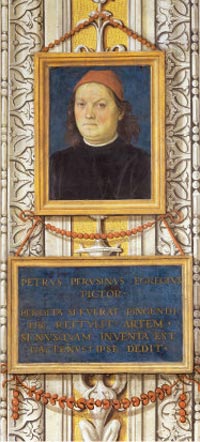
Pietro Perugino, self-portrait, Collegio del Cambio a Perugia, 1497–1500, Perugia |
 |
Pietro Perugino, Decorazioni a grottesche sul soffitto, 1497-1500, Collegio del Cambio, Perugia
|

Arte in Toscana | Giorgio Vasari, Le vite de' più eccellenti pittori, scultori e architettori (1550) | Pietro Perugino
Lives of the Most Eminent Painters Sculptors and Architects, Giorgio Vasari | download pdf
Pietro Perugino and the Trasimeno lake scenary | Renaissance and Mannerism Painting in Città della Pieve, Paciano, Panicale and Castiglione del Lago
Arte in Toscana | Pietro Perugino
Arte in Toscana | Pietro Perugino in Firenze
Scheda sul Collegio del Cambio | www.perugino.it
|
|
|
| |
|
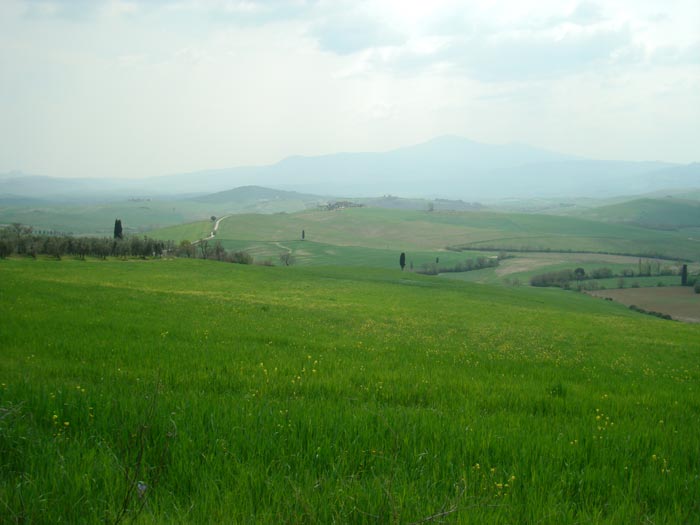 |
Val d'Orcia with Monte Amiata, view from Pienza, located to the north-east of the Monte Amiata
|

Podere Santa Pia is immersed in the utmost quietness where total privacy is guaranteed, in a scenic location 50 minutes away from both the sea and the Val d'Orcia National Park. For those wanting to get away and relax in idyllic countryside and lovely gardens yet be just a short drive from some one of Tuscany's most intoxicating cities, Santa Pia is the perfect choice.
The surrounding areas are full of towns of art: Montalcino with it's famous Brunello di Montalcino, Montepulciano and its historical centre, the poor theatre or “Teatro Povero” in Monticchiello, and Pienza and San Quirico d'Orcia, two small architectural masterpieces. Pienza is a wonderful medieval village placed in the artistic, natural and cultural park of the Val d'Orcia, which, due to its geometry and breathtaking views, is World Heritage Site since 2004. Pienza has some wonderful views over the orchid valley below, so be sure to climb up from the Piazza Dante Alighieri to the via Santa Caterina at the edge of the town and marvel at the wonderful panorama.
Holiday houses in Tuscany | Podere Santa Pia
|
| |
|
|
|
|
|
|

. |
|
 |
Podere Santa Pia |
|
Podere Santa Pia, garden view, April |
|
|
| |
|
|
|
|
|
|
|
|
|
Crete Senesi, surroundings
of Podere Santa Pia |
|
The abbey of Sant'Antimo |
|
San Quirico d'Orcia, Leonini Gardens |
| |
|
|
|
|
|
|
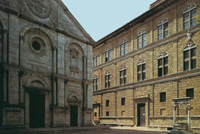
|
|
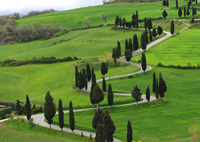
|
Cortona |
|
Pienza, Piazza Pio II |
|
Cipress road near Montichiello
|
| |
|
|
| |
|
|
The Maremma
|
|
|
Endowed with significant natural and environmental resources, the Maremma is today one of the best tourist destinations in Italy. The Maremma distinguishes itself from other areas of Italy thanks to its variety and wealth of natural environments. Situated in the hills between the Maremma coast and the Monte Amiata, Podere Santa Pia provides a lovely location to explore Southern Tuscany.
Monte Amiata is an ancient and now dormant volcano that has provided a home to Maremma’s earliest civilisations since the Bronze and Iron Ages. Still, it’s the tallest mountainous territory in the Tuscan Maremma at 1738 metres and is located between Siena and Grosseto.
Riserva Naturale Poggio all’Olmo
Within walking distance from Podere Santa Pia, on the edge of Castiglioncello Bandini, this nature reserve is not only a lovely place for a walk, it’s also the perfect place to get up close and personal with Monte Amiata’s famed flora and fauna. Monte Amiata provides a paradise for walkers in the summer and for skiers in the winter.
Cinigiano breathes the sea air and it bathes in the mountain landscape of sloping hills and dense oak forests and vineyards.Cinigiano, is renowned for its incredible wines. The Maremma’s ‘Strade del Vino’ are breathtaking wine trails that wind their way through the cities and landscapes that are, in their very essence, defined by the incredible wines they make.
There are three different ‘Strade del Vino’ in the Maremma. You can get all the maps and information you need from your local tourist information centre.
Strada del Vino Montecucco e dei Sapori dell’Amiata
The Amiata is known for its breathtaking landscape and mild climate. The trails that wind through here don’t just celebrate the wines, but other local delicacies like truffles, honey and saffron too.
Cingiano’s locals love their wine so much they’ve dedicated an entire festival to it. In October there is the Festa dell’Uva. Founded in 1966, the festival’s main purpose is to promote the unbeatable quality of the grapes grown in the territory and the unquestionably high quality wines they produce. During the festival, the town’s cellars are opened and locals and tourists alike line up to taste the wines,
Strada del Vino e dei Sapori Monteregio di Massa Marritima
Despite its peasants roots, the Massa Marritima area has, for centuries, been the refuge of artists. This wine trail aims to capture that high culture along with its culinary history.
Strada del Vino e dei Sapori Colli di Maremma
The best of the Collinare Maremmani with stops at all the towns in the Fiora and Albegna Valleys and the vineyards that make the best D.O.C wines in the north east of the Maremma.
Wine in Tuscany | Strada del Vino Montecucco
|
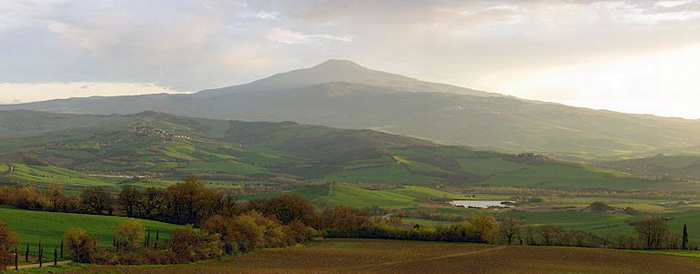 |
The volcanic cone of Monte Amiata dominates the southern panorama from Pienza |
| |
This article incorporates material from the Wikipedia articlse Pietro Perugino and Sala delle Udienze del Collegio del Cambio, published under the GNU Free Documentation License, and from Ornamentation of the Collegio del Cambio in Perugia, at www.wga.hu.
|
|
|
